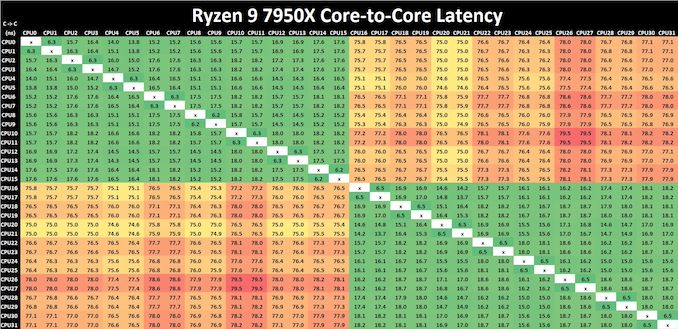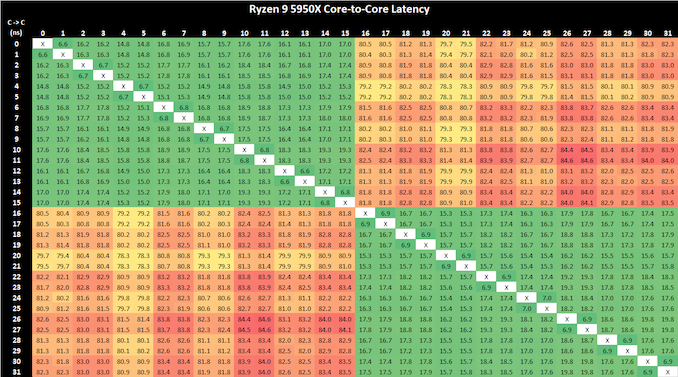AMD Zen 4 Ryzen 9 7950X and Ryzen 5 7600X Review: Retaking The High-End
by Ryan Smith & Gavin Bonshor on September 26, 2022 9:00 AM ESTCore-to-Core Latency
As the core count of modern CPUs is growing, we are reaching a time when the time to access each core from a different core is no longer a constant. Even before the advent of heterogeneous SoC designs, processors built on large rings or meshes can have different latencies to access the nearest core compared to the furthest core. This rings true especially in multi-socket server environments.
But modern CPUs, even desktop and consumer CPUs, can have variable access latency to get to another core. For example, in the first generation Threadripper CPUs, we had four chips on the package, each with 8 threads, and each with a different core-to-core latency depending on if it was on-die or off-die. This gets more complex with products like Lakefield, which has two different communication buses depending on which core is talking to which.
If you are a regular reader of AnandTech’s CPU reviews, you will recognize our Core-to-Core latency test. It’s a great way to show exactly how groups of cores are laid out on the silicon. This is a custom in-house test, and we know there are competing tests out there, but we feel ours is the most accurate to how quick an access between two cores can happen.

Click to enlarge (lots of cores and threads = lots of core pairings)
Comparing core to core latencies from Zen 4 (7950X) and Zen 3 (5950X), both are using a two CCX 8-core chiplet design, which is a marked improvement over the four CCX 16-core design featured on the Zen 2 microarchitecture, the Ryzen 9 3950X. The inter-core latencies within the L3 cache range from between 15 ns and 19 ns. The inter-core latencies between different cores within different parts of the CCD show a larger latency penalty of up to 79.5 ns, which is something AMD should work on going forward, but it's an overall improvement in cross CCX latencies compared to Zen 3. Any gain is still a gain.
Even though AMD has opted for a newer and more 'efficient' IOD which is based on TSMC's 6 nm node. It is around the same size physically as the previous AMD IOD on Zen 3 manufactured on GlobalFoundries 12 nm node, but with a much larger transistor count. Within the IOD is the newly integrated RDNA 2 graphics, although this isn't typical iGPU in the sense that an APU is. A lot of the room on the IOD is made up of the DDR5 memory controller or IMC, as well as the chips PCIe 5.0 lanes, and of course, connects to the logic through its primary interconnect named Infinity Fabric. All of these variables play a part on power, latency, and operation.

AMD Ryzen 9 5950X Core-to-Core Latency results
It's actually astounding how similar the latency performance of the Ryzen 9 7950X (Zen 4) is when compared directly to the Ryzen 9 5950X (Zen 3), despite being on the new 5 nm TSMC manufacturing process. Even with a change of IOD, but with the same interconnect, the inter-core latencies within the Ryzen 9 7950X are great in terms of cores within the same core complex; latency does degrade when pairing up with a core in another chiplet, but this works and AMD's Ryzen 5000 series proved that the overall penalty performance is negatable.










205 Comments
View All Comments
Gigaplex - Wednesday, September 28, 2022 - link
Because there's a massive market for gamers that aren't gaming at 4K. Competitive e-sports comes to mind, where the CPU matters. Replyscrizz - Thursday, September 29, 2022 - link
FACTS ReplySilver5urfer - Saturday, October 1, 2022 - link
A CPU is not just "muh Gaming" only processor. Which is why we have a ton of benchmarks here apart from Games. Second part is 1080P resolution is still one to bench, esp when you talking about sub i5 and R6 CPUs they are going to be a 1080P machine not a 4K display.Second, Nvidia is a trash company do not even try to defend that - Ampere GPUs shoved with GDDR6X for Bandwidth nice but on purpose for mining, okay fine it's all Crypto and etc. But the PCB designs for RTX3090 is dumpster fire. They put Memory module near PCIe interface which will get a ton of mechanical stress AND the whole MSVDD power rail is complete pile of BS. It is prone to failure because of horrible VRM components and to make it worse Nvidia marked the 3090 price 2x of 3080 and had like 15% boost and then the VRAM on the back total fail. They fixed all of them with 3090Ti but at the end of cycle. Now they will "optimize" the drivers to gimp RTX3090Ti to make 40 series good, thats how this garbage company rolls. Imagine DLSS2 getting EOLed by FSR and then killed by DLSS3. That's pure trash garbage.
Now the new RTX40 series is coming with rip off 4070 silicon at trash 192Bit bus which means it's a 4K class pricing (RTX3090 is $950, 3090Ti is $1K) but doesn't have proper memory and 12GB, plus the DLSS3 is fake trash, giving BS frames to get idiots drool over the frame counter which is funny because the frames are NOT real.
HEDT is dead, nobody wants to buy them because nowadays people only play trash games like Apex, Fortnite, COD and etc GaaS trash titles and they buy PC for that only, and how many people do you think care about X670E PCH bandwidth being same as X570 nobody, you did not even mention. Market killed it, I also want HEDT but it won't come again, AMD destroyed their own HEDT with half cooked trash worse than X299. Intel SPR is delayed so HEDT is not coming back ever again it's all TR Pro, XEON W. Shame. Reply
Qasar - Sunday, October 2, 2022 - link
you come across as one angry person. wow ReplySilver5urfer - Sunday, October 2, 2022 - link
I bought a 3090FE and now planning to sell it off because of it's TRASH VRAM on the back and BS power delivery system, Nvidia themselves revealed on RTX4090FE using literally 1:1 PCB from RTX3090Ti and claiming much lower power excursions.Now It's my fault but the thing I bought the 3090FE year back while 3090Ti came this year, It's a mistake on my part but Nvidia has been doing this BS since a while now. GTX970 VRAM fiasco, 2070 cutting silicon a step down just like now RTX4070, and the RTX3000 series awful power delivery VRM. Now DLSS3 which is fake the game runs at same lower FPS but they add fake data to make the people think they are running at higher FPS and rendering the game. Scam on top of scam. Reply
vortmax2 - Sunday, October 16, 2022 - link
Maybe focus on the content of his post instead of the demeanor. ReplyQasar - Thursday, October 20, 2022 - link
" Maybe focus on the content of his post instead of the demeanor. "you obviously havent seen his previous posts. Reply
Cristian - Tuesday, September 27, 2022 - link
The section : "Ryzen 9 7950X at 65 W (ECO Mode): Zen 4 has Superb Efficiency" is exactly what I was looking for (and will build) .Thank you very much Anandtech ( Ryan Smith & Gavin Bonshor) ! ;) Reply
TheinsanegamerN - Tuesday, September 27, 2022 - link
A 7600x3d would be a superb gaming chip, if AMD makes one. Limit zen 4 to 65w and honestly these are pretty tasty. Curious how cool a 7600 runs on limited TDP. Replynandnandnand - Tuesday, September 27, 2022 - link
It would be interesting if they could put a bottom yield chip with less cache on the 7600X, and bump up the price by $30. Otherwise I don't think they'll bother.Limit the TDP yourself. Reply